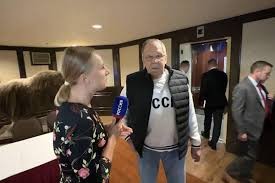Aug. 20—Interviewed by Russia’s VGTRK station Aug. 19 Russian Foreign Minister Sergey Lavrov assured listeners that “the atmosphere was quite good” in the meeting between Presidents Donald Trump and Russian President Vladimir Putin in Alaska—and distinctly different from the White House meeting of the seven European “leaders” who went to Washington as a “support group” for Volodymyr Zelenskyy.
Alaska “was a useful conversation. It showed without any doubt,” he said, “first, that the U.S. leader and his team are sincere in their commitment to achieving tangible results by bringing about something lasting, durable, and sustainable. This is what sets them apart from the Europeans who, at the time, shouted at every corner that they would not accept anything but a ceasefire, while continuing to supply weapons to Ukraine even after it is declared.”
Second, it showed that President Trump and his team understand that the Ukraine conflict “has its causes, which means that all the speculation alleging that Russia’s invasion of Ukraine was unprovoked,” as some Presidents and Prime Ministers of Europe say, “is just baby talk.”
President Trump and his team, particularly since the Alaska summit, “have adopted a far more substantive approach to resolving the Ukrainian crisis, recognizing the imperative to address its root causes,” Lavrov said. He cited two root causes. First, the five waves of NATO’s eastern expansion, despite such official commitments as the OSCE’s assertion that “security is indivisible, and no one may strengthen their own security at the expense of others”—which NATO violated. European leaders talked in Washington about Ukraine’s security—and [British PM Sir Keir] Starmer of Europe’s—but not one spoke of Russia’s security, Lavrov noted.
Another root cause: Zelenskyy’s Ukraine is the only country in the world to ban a language—Russian; his regime has stripped Russian-speakers of their rights and banned the Ukrainian Orthodox Church. Yet these European leaders say that “this is the man who must be in charge of striking a deal with Russia as he deems fit,” said Lavrov.
Lavrov gave a history lesson, when asked about Finnish President Alexander Stubb’s proposal that Ukraine adopt the Finnish model of 1944 as a solution. Finland in 1944 ended its military’s participation alongside Hitler in its war against Russia, and established relations with the Soviet Union, giving up a small part of its territory in the process. Finland, Lavrov pointed out, “whose military units participated in many war crimes” while fighting alongside Nazi Germany, then signed a treaty with the Soviet Union that stated “eternal neutrality, and that neither the Soviet Union nor Finland would ever join structures directed against the other,” has now joined NATO, “the structure that considers Russia as an enemy.”
Russia was never out to seize territory—not Crimea, nor the Donbass, nor Novorossiya; “our goal was to protect the Russian people who lived on these lands for centuries,” Lavrov remarked. The “root cause” to be eradicated, he repeated, is the policy of “the West, led by the previous administration of J. Biden,” of using Ukraine “as an instrument of containment, suppression of Russia and inflicting, as they say, a ‘strategic defeat’ [on Russia].”




